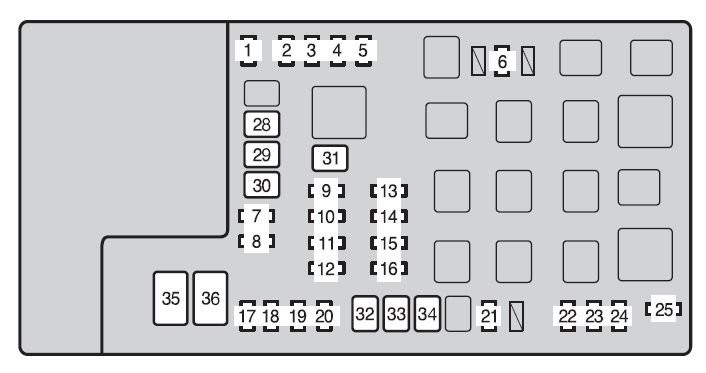The On-Board Diagnostics II (OBD2) port in your 2005 Toyota Tacoma is a crucial interface for vehicle diagnostics and emission testing. If you’re looking to check your engine codes, assess your vehicle’s health, or pass a smog check, knowing the 2005 Tacoma Obd2 Connector Location is the first step. This article will guide you to find it and offer troubleshooting steps if you encounter connection issues.
Locating the OBD2 Connector in Your 2005 Tacoma
For the 2005 Toyota Tacoma, the OBD2 connector is typically located inside the cabin for easy access. You can find it on the driver’s side, underneath the dashboard. Specifically, it is usually situated near the steering column, often just below the dash and above the pedals. You might need to crouch down and look under the dash to spot it. The connector is a 16-pin, trapezoid-shaped female port, which is the standard OBD2 configuration.
Once you’ve located the port, you’ll be able to plug in a compatible OBD2 scanner or diagnostic tool. This is essential for reading trouble codes, clearing the check engine light, and accessing real-time vehicle data.
Troubleshooting OBD2 Connector Issues
Sometimes, you might encounter issues when trying to connect to your 2005 Tacoma’s OBD2 port. Here are some troubleshooting steps, drawing from common experiences:
-
Check Your Scan Tool: The first step is to ensure your scan tool is functioning correctly. Try using it on another vehicle if possible, or test a different scan tool on your Tacoma. Borrowing a scanner from an auto parts store or repair shop can help rule out a faulty device.
-
Inspect the OBD Fuse: A blown fuse is a common cause of a non-functional OBD2 port. For a 2005 Toyota Tacoma, the fuse for the OBD2 system is often located in the engine bay fuse box. Refer to your owner’s manual for the exact location and fuse number, but it is frequently a 7.5 amp or 15 amp fuse. Visually inspect the fuse to see if the wire inside is broken. Replace it with a fuse of the same amperage if it’s blown.
-
Wiring and Connections: While less common, wiring issues can prevent the OBD2 port from working. Check the wiring around the OBD2 connector for any signs of damage, fraying, or loose connections. Tracing the wires back towards the fuse box and ECU (Engine Control Unit) might be necessary if you suspect a wiring problem. This is a more complex step and might require professional assistance if you’re not comfortable with automotive electrical systems.
-
Try a Powered OBD2 Scanner: Some OBD2 scanners are powered by the vehicle’s battery through the OBD2 port itself. If there’s a power delivery issue to the port, these scanners might fail to connect. Try using a powered OBD2 scanner, which has its own battery source. As mentioned in the original experience, a scanner with its own power supply can sometimes bypass a power delivery problem to the OBD2 port.
-
Battery Reset: A simple reset can sometimes resolve communication glitches. Disconnect your Tacoma’s battery for about 30 seconds, then reconnect it. This can sometimes reset the vehicle’s computer system and restore OBD2 port functionality.
-
ECU Issues (Less Likely): In rare cases, a malfunctioning ECU could be the cause of OBD2 port problems. However, this is usually a last resort diagnosis after checking all other potential issues. ECU problems often manifest with other noticeable vehicle performance issues.
 Toyota-tacoma-mk2-fuse-box-engine-compartment-type-a-2012.jpg
Toyota-tacoma-mk2-fuse-box-engine-compartment-type-a-2012.jpg
Conclusion
Finding the 2005 tacoma obd2 connector location is generally straightforward in your Toyota Tacoma. It’s usually under the dashboard on the driver’s side. If you’re having trouble connecting to it, systematically go through the troubleshooting steps, starting with the easiest fixes like checking the fuse and trying a different scanner. If you’ve exhausted these steps and are still facing issues, it’s advisable to consult a professional mechanic or a Toyota dealership to diagnose and resolve the problem accurately. A functional OBD2 port is essential for vehicle maintenance and ensuring your 2005 Toyota Tacoma runs smoothly and passes all necessary emissions tests.